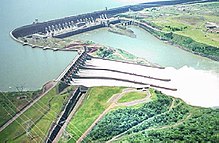
Back مشروع عملاق Arabic Мегапроект Bulgarian Megaprojecte Catalan Megaprojekt Danish مگاپروژه Persian Macroingénierie French מגה פרויקט HE महापरियोजना Hindi メガプロジェクト Japanese 메가프로젝트 Korean
This article may lend undue weight to the opinion of Flyvbjerg et al. (September 2023) |


A megaproject is an extremely large-scale construction and investment project.[1] According to the Oxford Handbook of Megaproject Management, "Megaprojects are large-scale, complex ventures that typically cost $1 billion or more, take many years to develop and build, involve multiple public and private stakeholders, are transformational, and impact millions of people".[2] However, $1 billion is not a constraint in defining megaprojects; in some contexts a relative approach is needed, such as in developing countries, where a much smaller project (such as one with a $100 million budget) could constitute a megaproject. Therefore, a more general definition is "Megaprojects are temporary endeavours (i.e. projects) characterised by: large investment commitment, vast complexity (especially in organisational terms), and long-lasting impact on the economy, the environment, and society".[3]
Bent Flyvbjerg, a professor at the Saïd Business School of the University of Oxford says that globally, megaprojects make up 8 percent of total global GDP.[4] Megaprojects refer not only to construction projects but also decommissioning projects, which are projects that can reach multi-billion budgets, and have a high level of innovation and complexity, and are affected by a number of techno-socio-economic and organizational challenges.[5][6]
The OFCCP Mega Construction Project (Megaproject) Program involves projects valued at over $35 million.[7]
- ^ "Megaproject: The Effective Design and Delivery of Megaprojects in the EU". European Cooperation in Science and Technology.
- ^ Flyvbjerg, Bent (2017). The Oxford Handbook of Megaproject Management. Oxford University Press. p. 2. ISBN 978-0198732242.
- ^ Brookes, Naomi J.; Locatelli, Giorgio (2015-10-01). "Power plants as megaprojects: Using empirics to shape policy, planning, and construction management" (PDF). Utilities Policy. 36: 57–66. doi:10.1016/j.jup.2015.09.005. S2CID 8165155.
- ^ Flyvbjerg, Bent (7 Apr 2014). "What You Should Know About Megaprojects and Why: An Overview". Project Management Journal. 45 (2): 6–19. arXiv:1409.0003. Bibcode:2014arXiv1409.0003F. doi:10.1002/pmj.21409. S2CID 153469512. SSRN 2424835.
- ^ Invernizzi, Diletta Colette; Locatelli, Giorgio; Brookes, Naomi J. (October 2017). "Managing social challenges in the nuclear decommissioning industry: A responsible approach towards better performance". International Journal of Project Management. 35 (7): 1350–1364. doi:10.1016/j.ijproman.2016.12.002.
- ^ Invernizzi, Diletta Colette; Locatelli, Giorgio; Grönqvist, Marcus; Brookes, Naomi J. (2019-01-28). "Applying value management when it seems that there is no value to be managed: the case of nuclear decommissioning". International Journal of Project Management. 37 (5): 668–683. doi:10.1016/j.ijproman.2019.01.004. ISSN 0263-7863. S2CID 115941020. Archived from the original on 1 Feb 2019. Alt URL
- ^ "Office of Federal Contractor Compliance Programs: Mega Construction Project Program".
© MMXXIII Rich X Search. We shall prevail. All rights reserved. Rich X Search